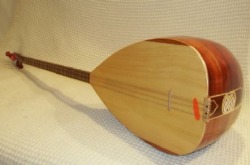Baglama
The bağlama (Turkish: bağlama, from bağlamak, "to tie", pronounced [baːɫaˈma]) is a stringed musical instrument shared by various cultures in the Eastern Mediterranean, Near East, and Central Asia.
It is sometimes referred to as the saz (from the Persian ساز, meaning a kit or set), although the term "saz" actually refers to a family of plucked string instruments, long-necked lutes used in Ottoman classical music, Turkish folk music, Azeri music, Kurdish music, Persian music, Assyrian music, and in parts of Syria, Iraq and the Balkan countries. The bağlama is the most common of these, and is often called by the generic name; according to The New Grove Dictionary of Music and Musicians, "the terms "bağlama" and "saz" are used somewhat interchangeably in Turkey."[1] Like the Western lute and the Middle-Eastern oud, it has a deep round back, but a much longer neck. It can be played with a plectrum or with a fingerpicking style known as şelpe.
In the music of Greece the name baglamas (Greek μπαγλαμάς) is given to a treble bouzouki, a related instrument. The Turkish settlement of Anatolia from the late tenth century onward saw the introduction of a two-string Turkmen dutar, which was played in some areas of Turkey until recent times.
http://en.wikipedia.org/wiki/Ba%C4%9Flama
It is sometimes referred to as the saz (from the Persian ساز, meaning a kit or set), although the term "saz" actually refers to a family of plucked string instruments, long-necked lutes used in Ottoman classical music, Turkish folk music, Azeri music, Kurdish music, Persian music, Assyrian music, and in parts of Syria, Iraq and the Balkan countries. The bağlama is the most common of these, and is often called by the generic name; according to The New Grove Dictionary of Music and Musicians, "the terms "bağlama" and "saz" are used somewhat interchangeably in Turkey."[1] Like the Western lute and the Middle-Eastern oud, it has a deep round back, but a much longer neck. It can be played with a plectrum or with a fingerpicking style known as şelpe.
In the music of Greece the name baglamas (Greek μπαγλαμάς) is given to a treble bouzouki, a related instrument. The Turkish settlement of Anatolia from the late tenth century onward saw the introduction of a two-string Turkmen dutar, which was played in some areas of Turkey until recent times.
http://en.wikipedia.org/wiki/Ba%C4%9Flama




